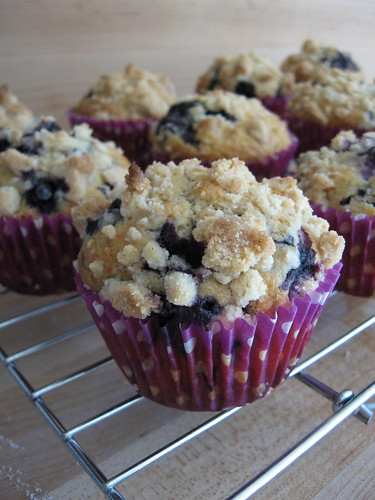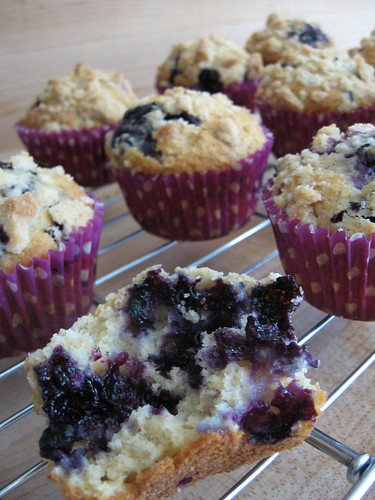This morning I woke up and just couldn't take it any more. It was a perfect morning for baking—our skies were clearing after a few days of rain, and the whole house was chilly.
I've had a bit of an obsession with muffins lately. Good muffins are sweet but not sticky, substantial but not heavy. They're quick to make, and rarely require more than you have in your pantry, and if you have a small family like I do, odds are good that you'll have leftovers for the next day.

I'm equal-opportunity when it comes to muffins. I like the newfangled orange-cranberry and the classic almond-poppy seed (although I prefer lemon); I enjoy more cake-like chocolate and barely-sweet corn; I'm happy to gobble up gingerbread and banana alike. Recently I've made doughnut muffins and spice muffins, and I just bought bran, but mostly, I've been experimenting with blueberries.

Blueberry muffins have always been my favorites; they're a lesson in simplicity. The fruit greatly reduces the structural integrity of the muffin (particularly while warm), so I like to counteract that with some whole wheat pastry flour, a bit sturdier than white flour. I like to spike the batter with a few good pinches of mace or nutmeg, but the most important element is certainly the berries. I still have a few cups of blueberries from home in my freezer, but when I need to buy them I try to find small, wild Boreal blueberries, as they seem to have the best flavor. While I don't hesitate to use fresh berries when I have them, I find that frozen berries reduce or eliminate the purple streaks that are the bane of so many berry-lovers. These muffins are chock-full of berries and will stain your fingers purple if given half a chance—just like they should be.

Blueberry Muffins with Cinnamon Streusel
Adapted from the Stone-Buhr Cookbook
Baking manuals usually abound with instructions to have all ingredients at room temperature, but for this recipe, I recommend keeping the milk and egg cold. The blueberries are frozen, and having a cool batter will slow down the thawing process and help reduce any unnecessary purple streaks.
For the streusel:
3 tablespoons butter, melted
3 tablespoons sugar
pinch cinnamon
½ cup flour, divided
For the muffins:
1 cup whole wheat pastry flour
¾ cup unbleached white flour
5 tablespoons sugar
2 ½ teaspoons baking powder
¾ teaspoon salt
2 pinches mace or nutmeg
1 egg, lightly beaten (cold)
¾ cup milk (cold)
⅓ cup oil or butter, melted and cooled
1 cup blueberries, kept frozen
Preheat the oven to 400ºF. To make the streusel, mix the melted butter, sugar, cinnamon, and ¼ cup flour. Add additional flour by tablespoonfuls until the mixture crumbles but holds clumps easily; set aside.
Grease a muffin pan or line with paper or foil liners; set aside. Mix the flours, sugar, baking powder, salt, and nutmeg in a large bowl with a fork or whisk. Make a well in the center and add the egg, milk, and the oil or butter. Fold the ingredients together swiftly with a spatula, folding three or four times. Add the blueberries and quickly mix to distribute - the dry ingredients should be just moistened.
Distribute the batter in the muffin pan (I often leave one empty to keep the muffins nice and tall). Sprinkle the streusel over the top of the muffins—if you have leftover streusel, you can cover it and refrigerate for up to a week.
Bake 30-35 minutes, until golden brown. Remove from the pan and cool on a rack for at least 10 minutes.
Reheat any leftovers in the microwave or in a 250ºF oven.
Makes about 12 muffins
